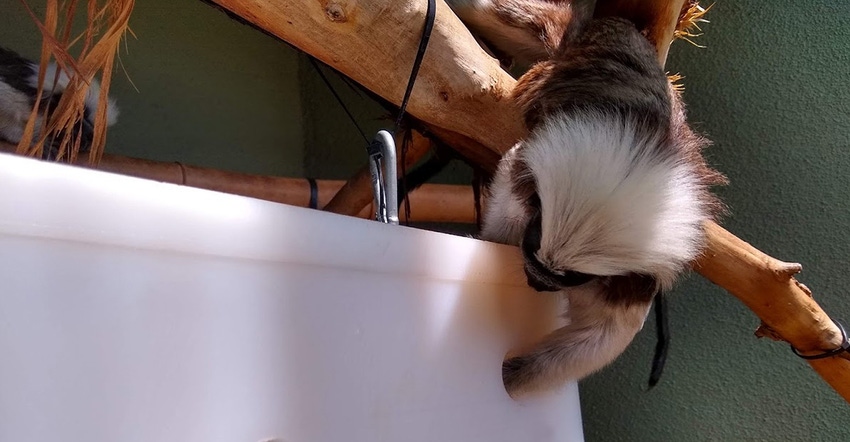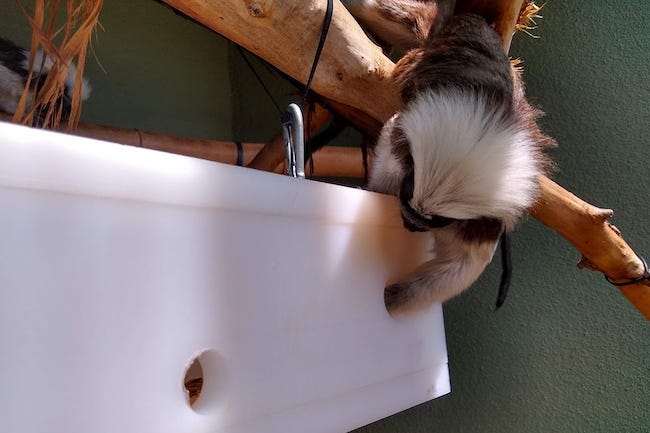Plastic Sheets Contribute to Monkeys’ ‘Cognitive Enrichment’ at Phoenix Zoo
Curbell Plastics donated scrap UHMW sheets for the zoo’s primate exhibits. The material was used to fabricate durable foraging feeders, which serve as cognitive enrichment tools and foster natural behaviors one might see in the wild.
July 22, 2020

When the cotton-top tamarins and squirrel monkeys at the Phoenix Zoo needed “cognitive enrichment foraging boxes,” Curbell Plastics Inc. (Orchard Park, NY) stepped up to provide the materials. Curbell supplies lightweight, durable performance plastics for commercial and industrial applications, as well as fabricated plastic parts, through its 21 locations nationwide.
Jackie Hensley, a primate keeper at the Phoenix Zoo, explained: “Foraging feeders are one of many types of enrichment we use at the zoo. We give enrichment to our animals every day, which brings out varied and natural behaviors you would see in the wild, and it keeps the animals active and thinking throughout the day.” Hensley reached out to area businesses to see if any would be interested in donating materials to the zoo for this important project.
Curbell Plastics Phoenix Business Manager Rich Ineson received an e-mail from Hensley requesting materials for the feeders. Since Curbell is always looking for opportunities to recycle, reuse, and reduce plastic scrap and waste, he thought of two sheets of very tough, unfilled ultra-high molecular weight (UHMW) scrap material of differing sizes.
Ineson connected with Hensley to confirm the zoo’s specifications. He learned that the material needed to be durable enough to withstand daily physical abuse by the moneys — who might knock it to the ground or chew it — but not so thick that it would be difficult to machine. He offered Hensley the sheets, which she accepted and made arrangements to pick up. By the end of the week, the UHMW sheets were in the zoo’s machine shop.
|
A cotton-top tamarin at the Phoenix Zoo explores a foraging box feeder made from UHMW scrap material donated by Curbell Plastics. Image courtesy Curbell Plastics. |
Several weeks later, and shortly before his official retirement date, Ineson received an e-mail with photos of the first completed set of feeder boxes made from the donated sheets. Zoo personnel had machined long rectangular boxes with sliding tongue and groove end caps as well as hand holes drilled along the sides. The tops were secured with large screw eye bolts so the feeders could be hung lengthwise along branches, explained Curbell. Because UHMW is a tough material, there is little concern that the feeders will corrode, splinter, or rot, delivering many years of use to the zoo.
“With the generous donation of plastic sheets from Curbell Plastics to our Phoenix Zoo primate department, we were able to make nine foraging box feeders for our squirrel monkeys and cotton-top tamarins,” Hensley reported. “The animals like the challenge of new enrichment items and seeing what is inside. Guests also enjoy learning about and watching the animals interact with the enrichment items.”
Curbell Plastics commented that it was happy for the opportunity to act on the company’s environmental pledge, which includes (but is not limited to) reducing waste and pollution, optimizing the use of energy and materials, and investing in the communities where the company operates.
About the Author(s)
You May Also Like





